Papers by Naser Movahedinia
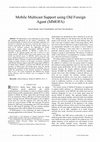
World Academy of Science, Engineering and Technology, International Journal of Electrical, Computer, Energetic, Electronic and Communication Engineering, 2007
IP multicasting is a key technology for many existing and emerging applications on the Internet. ... more IP multicasting is a key technology for many existing and emerging applications on the Internet. Furthermore, with increasing popularity of wireless devices and mobile equipment, it is necessary to determine the best way to provide this service in a wireless environment. IETF Mobile IP, that provides mobility for hosts in IP networks, proposes two approaches for mobile multicasting, namely, remote subscription (MIP-RS) and bi- directional tunneling (MIP-BT). In MIP-RS, a mobile host re- subscribes to the multicast groups each time it moves to a new foreign network. MIP-RS suffers from serious packet losses while mobile host handoff occurs. In MIP-BT, mobile hosts send and receive multicast packets by way of their home agents (HAs), using Mobile IP tunnels. Therefore, it suffers from inefficient routing and wastage of system resources. In this paper, we propose a protocol called Mobile Multicast support using Old Foreign Agent (MMOFA) for Mobile Hosts. MMOFA is derived from MIP-RS an...
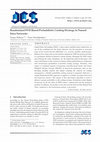
Named Data Networking (NDN), a data-centric enabled-cache architecture, as one of the candidates ... more Named Data Networking (NDN), a data-centric enabled-cache architecture, as one of the candidates for the future Internet, has the potential to overcome many of the current Internet difficulties (e.g., security, mobility, multicasting). Influenced by using cache in intermediate equipment, NDN has gained attention as a prominent method of Internet content sharing. Managing the NDN caches and reducing the cache redundancy are the important goals in this paper. Our main contribution in this research is toward caching optimization in comparison with betweenness probabilistic in-network caching strategy. Therefore, with respect to combined impacts of long-term centrality-based metric and Linear Weighted Moving Average (LWMA) of short-term parameters such as user incoming pending requests and unique outgoing hit requests on caching management, a flexible probability caching strategy is proposed. Moreover, a simple Randomized-SVD approach is applied to combine averaged short-term and long-t...
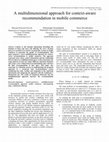
—Context as the dynamic information describing the situation of items and users and affecting the... more —Context as the dynamic information describing the situation of items and users and affecting the user’s decision process is essential to be used by recommender systems in mobile commerce to guarantee the quality of recommendation. This paper proposes a novel multidimensional approach for context-aware recommendation in mobile commerce. The approach represents users, items, context information and the relationship between them in a multidimensional space. It then determines the usage patterns of each user under different contextual situations and creates a new 2-dimensional recommendation space and does the final recommendation in that space. This paper also represents an evaluation process by implementing the proposed approach in a restaurant food recommendation system considering day, time, weather and companion as the contextual information and comparing the approach with the traditional 2-dimensional one. The results of comparison illustrates that the multidimensional approach i...
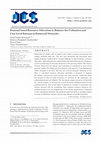
Femtocells are widely used to improve poor indoor coverage and decrease the cellular networks hig... more Femtocells are widely used to improve poor indoor coverage and decrease the cellular networks high cost. The fact that femtocells and macrocells share similar frequency bands leads to a major challenge in time/frequency resources allocation. Addressing fairness among femtocells and improving time/frequency resources utilization are the main objectives of the previous studies. The balance between femtocell level fairness and utilization is considered in some of the previous studies. Providing user level fairness with respect to User Equipments (UEs) demands is the issue that has not received adequate attention so far. Here, a centralized resource allocation algorithm is proposed to improve the balance between user level fairness and radio resource utilization where the demand of UEs for radio resources are involved. In this algorithm, two independent phases are followed. The first phase assigns resources to femtocells in a greedy manner to increase the reused spectrum utilization bas...
In this article, a method has been offered to classify normal and defective tiles using wavelet t... more In this article, a method has been offered to classify normal and defective tiles using wavelet transform and artificial neural networks. The proposed algorithm calculates max and min medians as well as the standard deviation and average of detail images obtained from wavelet filters, then comes by feature vectors and attempts to classify the given tile using a Perceptron neural network with a single hidden layer. In this study along with the proposal of using median of optimum points as the basic feature and its comparison with the rest of the statistical features in the wavelet field, the relational advantages of Haar wavelet is investigated. This method has been experimented on a number of various tile designs and in average, it has been valid for over 90% of the cases. Amongst the other advantages, high speed and low calculating load are prominent.
The Journal of Supercomputing

Wireless Personal Communications
Benefiting from unlimited power supply, vehicular ad hoc networks (VANETs), in a 5G platform, can... more Benefiting from unlimited power supply, vehicular ad hoc networks (VANETs), in a 5G platform, can deal superiorly with the challenges of providing high reliability. As a prerequisite for ensuring reliability, reducing message delivery delay is pursued by improving the performance of message broadcast protocol. The amount of exchanged overhead to select a relay node, and the time consumed to forward a message are the two foremost factors in this regard. In the other hand, cognitive radio (CR) and device-to-device (D2D) communication techniques have been considered inherently in 5G to overcome bandwidth shortage, coverage limitation and excessive delay. So, in this article, we study some relay selection algorithms appropriate for 5G-VANET and classify them based on network reliability requirements. Considering the capabilities of CR and D2D communications in 5G-VANET, a method is proposed to select the farthest available node to forward a message without any need to exchange control messages with other vehicles. Unlike other existing works, we decrease the impact of control data overhead on network reliability in terms of message delivery hops and delay. Our simulation results show the proposed method can significantly increase network reliability by reducing message delivery delay, as well as the number of hops needed to deliver a message to the furthermost vehicles in a platoon.
International Journal of Communication Systems
International Journal of Communication Systems
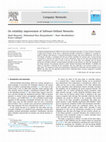
Computer Networks
In Software-Defined Networks (SDNs) the role of the centralized controller is crucial, and thus i... more In Software-Defined Networks (SDNs) the role of the centralized controller is crucial, and thus it becomes a single point of failure. In this work, a distributed controller architecture is explored as a possible solution to improve fault tolerance. A network partitioning strategy, with small subnetworks, each with its own Master controller, is combined with the use of Slave controllers for recovery aims. A novel formula is proposed to calculate the reliability rate of each subnetwork, based on the load and considering the number and degree of the nodes as well as the loss rate of the links. The reliability rates are shared among the controllers through a newly-designed East/West bound interface, to select the coordinator for the whole network. This proposed method is called "Reliable Distributed SDN (RDSDN)." In RDSDN, the failure of controllers is detected by the coordinator that may undertake a fast recovery scheme to replace them. The numerical results prove performance improvement achievable with the adoption of the RDSDN and show that this approach performs better regarding failure recovery compared to methods used in related research.

Journal of Network and Systems Management
Internet infrastructure is going to be re-designed as a core network layer, shifting from hosts t... more Internet infrastructure is going to be re-designed as a core network layer, shifting from hosts to contents. To this end, content centric networking (CCN) as one of the most effective architectures has been proposed with significant features of in-network caching to open new possibilities for energy efficiency in content dissemination. However in energy-efficient CCN, less popular contents are cached near the origin server, and therefore in delay sensitive applications with less popularity, it leads to dropping delayed chunks, increasing energy waste, and degrading the quality of service (QoS). In the present paper, the energy consumption in CCN while being aware of QoS consideration in terms of imposed delay is minimized. The minimization is performed through integer linear programming by considering most of the energy consuming components. However, since this problem is NP-hard, a quantized Hopfield neural network with an augmented Lagrange multiplier method (MEDCCN-QHN) is proposed to derive the solution. The numerical results show that the MEDCCN-QHN achieves to better delay profile compared to the optimal energy-efficient algorithm, and near-optimal energy consumption. Moreover, the method is fast due to its parallel execution capability.

Wireless Personal Communications
Vehicular Ad hoc Networks (VANETs) are introduced to improve the performance of Intelligent Trans... more Vehicular Ad hoc Networks (VANETs) are introduced to improve the performance of Intelligent Transportation Systems (ITS). As safety is the most important purpose of VANETs, reliability is one of their main necessities. In the other hand, regarding the popularity of VANETs in the future of auto-technologies, the lack of bandwidth in peak traffic hours seems to be one of the most important challenges. For this purpose, utilizing Cognitive Radio (CR) technology in VANETs appears to be a proper candidate. Making the most of CR-VANETS capabilities involves cooperation between the vehicles which in turns necessitates a comprehensive trust management system among them. Considering the concept of reliability in CR-VANETs in this article, employment of trust as a mean of improving reliability is investigated. Classifying the node’s misbehaviors into three categories of selfish, malicious and incapable, a model for evaluating reliability is derived, based on which a trust based framework is presented to improve the reliability of VANET’s transmission media access. Simulation results show that considering cognitive radio and trust together can improve the reliability of VANET and can decrease the number of accidents in peak traffic hours.
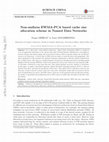
Science China Information Sciences
As a data-centric cache-enabled architecture, Named Data Networking (NDN) is considered to be an ... more As a data-centric cache-enabled architecture, Named Data Networking (NDN) is considered to be an appropriate alternative to the current host-centric IP-based Internet infrastructure. Leveraging innetwork caching, name-based routing, and receiver-driven sessions, NDN can greatly enhance the way Internet resources are being used. A critical issue in NDN is the procedure of cache allocation and management. Our main contribution in this research is the analysis of memory requirements to allocate suitable Content-Store size to NDN routers, with respect to combined impacts of long-term centrality-based metric and Exponential Weighted Moving Average (EWMA) of short-term parameters such as users behaviours and outgoing traffic. To determine correlations in such large data sets, data mining methods can prove valuable to researchers. In this paper, we apply a data-fusion approach, namely Principal Component Analysis (PCA), to discover relations from short-and long-term parameters of the router. The output of PCA, exploited to mine out raw data sets, is used to allocate a proper cache size to the router. Evaluation results show an increase in the hit ratio of Content-Stores in sources, and NDN routers. Moreover, for the proposed cache size allocation scheme, the number of unsatisfied and pending Interests in NDN routers is smaller than the Degree-Centrality cache size scheme.

The Journal of Supercomputing, 2016
A possible candidate for implementing smart grid neighborhood area network (NAN) is wireless comm... more A possible candidate for implementing smart grid neighborhood area network (NAN) is wireless communications because of its advantages, such as flexibility and low installation and maintenance cost. However, one of the problems with wireless communication is its unreliability, whereas communication reliability is a basic requirement of smart grid applications. In this paper, we consider a wireless mesh network for NAN and then propose a method on the basis of hop-by-hop ARQ that achieves the required data communication reliability in wireless NAN and, at the same time, satisfies the communication latency constraint which is another requirement of smart grid applications. The proposed approach provides the optimal number of allowed retransmissions at each hop considering the loss probabilities of all hops and end-to-end delay constraint. Comparing to the typical application of ARQ in which the number of retransmissions permitted is the same at each hop, it is demonstrated that the proposed approach achieves a higher level of reliability while meeting the delay constraint. Moreover, the proposed method is evaluated by simulation, and the results are consistent with the results of the theoretical model.

Journal of Intelligent & Fuzzy Systems, 2016
5 Abstract. Finding community structures in online social networks is an important methodology fo... more 5 Abstract. Finding community structures in online social networks is an important methodology for understanding the internal organization of users and actions. Most previous studies have focused on structural properties to detect communities. They do not analyze the information gathered from the posting activities of members of social networks, nor do they consider overlapping communities. To tackle these two drawbacks, a new overlapping community detection method involving social activities and semantic analysis is proposed. This work applies a fuzzy membership to detect overlapping communities with different extent and run semantic analysis to include information contained in posts. The available resource description format contributes to research in social networks. Based on this new understanding of social networks, this approach can be adopted for large online social networks and for social portals, such as forums, that are not based on network topology. The efficiency and feasibility of this method is verified by the available experimental analysis. The results obtained by the tests on real networks indicate that the proposed approach can be effective in discovering labelled and overlapping communities with a high amount of modularity. This approach is fast enough to process very large and dense social networks. 6 7 8 9 10 11 12 13 14 15 16

Peer-to-Peer Networking and Applications, 2016
The communication network of a Smart Grid has a three-level hierarchical structure consisting of ... more The communication network of a Smart Grid has a three-level hierarchical structure consisting of Home Area Network (HAN), Neighborhood Area Network (NAN) and Wide Area Network (WAN). Wireless communication, due to its advantages, is identified as a potential candidate for Smart Grid communications, especially in HAN and NAN. However, wireless transmission is inherently unreliable, whereas communication reliability is one of the fundamental requirements of Smart Grid applications. In this paper, a two-layer communication model based on IEEE reference grids is considered for NAN and a method based on transmission redundancy is proposed to improve the reliability of wireless communications in NAN, while the communication delay requirement of the Smart Grid is considered as a restriction. The proposed method finds the optimum number of transmissions at each hop with respect to the loss probability and total delay constraints. Comparing the proposed method to the case of an equal number of transmissions for all the hops, it is shown by analysis that the proposed method achieves a superior reliability while meeting the delay requirement. In addition, the simulation-based evaluation of the proposed method supports the validity of the results obtained from the analytical model.
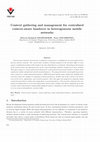
Turkish Journal of Electrical Engineering and Computer Sciences, 2012
Context-aware handover decision has recently been considered as a candidate for next-generation h... more Context-aware handover decision has recently been considered as a candidate for next-generation heterogeneous wireless networks. The context-aware handover methods proposed in the literature differ in some aspects, including the location of the handover decision (distributed or centralized). Depending on the location of the decision point, the appropriate part of the context knowledge should be transferred in those methods. This paper proposes a context gathering mechanism for a policy-based context-aware handover method, which implements mobile-initiated and network-assisted handover. The proposed network context gathering mechanism is based on a media-independent handover (MIH) framework and the paper justifies the usability of the extension using some analysis on signaling overhead and latency. Another part of the context is the preferences of the users, applications, and network operators, where this paper has proposed an automatic policy construction procedure to gather and employ them in generating policies. This procedure eliminates the complexity of making policies in previous policy-based context-aware methods and allows employing up-to-date network context information to dynamically modify the policies. Simulation results show better performance in terms of perceived quality for sensitive traffic.

Transferring real-time traffic such as voice and video over wireless LAN network (WLAN) requires ... more Transferring real-time traffic such as voice and video over wireless LAN network (WLAN) requires stringent delay and jitter requirements. One of the methods to provide QoS in this standard is Enhanced Distributed Channel Access (EDCA) which benefits form the concept of traffic categories. However, EDCA is a contention based method; therefore it can not guarantee strict QoS required by real-time services without proper network control mechanisms. One of the challenging problems in wireless networks is the failure of transmitting media due to fading. Normally the node does not differentiate between the media access collision and the channel failure. The performance of this method in case of fading channel has not yet been evaluated. In this paper, we analyze the effect of loss and delay caused by fading channel on EDCA performance. Then, we propose a modification to the media access scheme to elevate the performance against channel failures. Moreover an adjustment for the maximum numb...
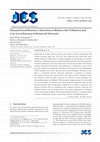
Femtocells are widely used to improve poor indoor coverage and decrease the cellular networks hig... more Femtocells are widely used to improve poor indoor coverage and decrease the cellular networks high cost. The fact that femtocells and macrocells share similar frequency bands leads to a major challenge in time/frequency resources allocation. Addressing fairness among femtocells and improving time/frequency resources utilization are the main objectives of the previous studies. The balance between femtocell level fairness and utilization is considered in some of the previous studies. Providing user level fairness with respect to User Equipments (UEs) demands is the issue that has not received adequate attention so far. Here, a centralized resource allocation algorithm is proposed to improve the balance between user level fairness and radio resource utilization where the demand of UEs for radio resources are involved. In this algorithm, two independent phases are followed. The frst phase assigns resources to femtocells in a greedy manner to increase the reused spectrum utilization base...

Journal of the Chinese Institute of Engineers, 2015
Grid computing is comprised of many distributed nodes in order to compute and analyze a set of di... more Grid computing is comprised of many distributed nodes in order to compute and analyze a set of distributed data. To improve the processing performance, an appropriate load-balancing algorithm is required to equally distribute loads among the grid’s nodes. In this article, an algorithm based on ant colony optimization is proposed to deal with load-balancing problems. In this approach, when an ant reaches a node, the ant’s table and the node’s table exchange their information and update each other. In order to move to the most appropriate node, the ant selects the next node from the current node’s table according to the nodes’ loads and their CPU rates. This process is continued until the ant passes the predefined steps. The experimental results show that while implementing the proposed algorithm to the grid environment, increasing the number of jobs and their length has insignificant impact on the system response time.

Uploads
Papers by Naser Movahedinia